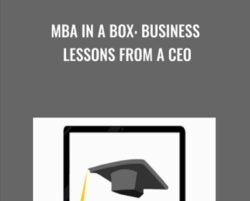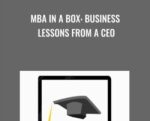This is the only online course you need to acquire the business acumen to:Start up your own businessGrow your existing ventureTake your career to the next levelGet promoted and apply managerial, financial, marketing, decision-making and negotiation skills in the real business worldHave an all-around view of why some companies (and people) succeed when doing business and why others do notThis course is jam-packed with the same useful information and real-life case studies MBA graduates acquire throughout their training in top-tier business schools. We have even tried to make it more interactive by preparing a gamebook for you. Yeah, that’s right! Learning business and finance need not be boring!The gamebook will test what you have learned and will simulate a real-world environment in which your decisions as a business executive will have real monetary consequences for a company. Can you think of any better way to reinforce what you have learned?An exciting journey from A-Z.If you are a complete beginner and you know nothing about business or finance, don’t worry at all! In each of the five main modules of the course, we will start from the very basics and will gradually build up your knowledge. The course contains plenty of real-life examples and case studies that make it easy to understand.Five modulesMBA in a box is a collection of the five courses that are most frequently taught to MBA students. We have carried out extensive research and explored the curriculums of the most successful MBA programs around the world including Harvard Business School, Wharton School of the University of Pennsylvania, INSEAD, Booth School of Business, London Business School and others. This is the reason the following modules have been included in this program:Business StrategyManagement and HR ManagementMarketing Communications and Marketing ManagementAccounting and Financial Statement AnalysisDecision Making, Persuasion, and NegotiationGet MBA in a Box: Business Lessons from a CEO – Anonymous, Only Price $57Teaching is our passionFor over six months, we worked hard to create the best possible MBA course that will deliver the most value for you. We want you to succeed, which is why the course tries to be as engaging as possible. High-quality animations, superb course materials, a gamebook simulation, quiz questions, handouts and course notes, as well as a glossary with new terms are some of the extra perks you will get by subscribing.What makes this course different from the rest of the Business courses out there?High-quality production – HD video and animations (This isn’t a collection of boring lectures!)Knowledgeable instructor (CEO of an 8 digit business)Complete training – we will cover all major topics and skills you need to become an entrepreneur, a successful investor, or a business executiveExtensive Case Studies that will help you reinforce everything that you’ve learnedGamebook – solve our Gamebook and make this course an interactive experience to test what you’ve learned while taking the courseExcellent support – if you don’t understand a concept or you simply want to drop us a line, you’ll receive an answer within 1 business dayDynamic – we don’t want to waste your time! The instructor keeps up a very good pace throughout the whole courseBonus prizes – upon completion of 50% and 100% of the course, you will receive two bonus giftsWhy do you need these skills?Salary/Income – it is not a coincidence that MBA graduates earn 40% more than their peers – they have the skills and knowledge that allows them to see the bigger picture. This course would allow you to do just that – see the bigger picture and have a holistic view of why certain businesses succeed and what needs to be done to improve their performancePromotions – MBA students acquire valuable technical skills, which makes them the leading candidates for senior roles within corporationsSecure Future – there is high demand for skilled business executives on the job market, and you won’t have to be concerned about finding a jobGrowth – this isn’t a boring job. Every day, you will face different challenges that will challenge your existing skillsCourse CurriculumMBA in a Box: IntroductionWhat does the course cover? (4:51)Strategy: An IntroductionThe role of Strategy and what makes a Strategy successful (5:19)The difference between Corporate and Business Strategy (4:13)The importance of the Mission, Vision, Goals, and Value statements (6:15)Strategy: The Industry lifecycle modelThe strategic importance of the industry lifecycle model (1:44)The four stages of the industry lifecycle model – An introduction (3:17)The Introduction stage – A new industry is born (4:46)The Growth stage – An industry in its expansion phase (3:21)The Maturity stage – An industry at its peak (2:52)The Decline stage – An obsolete industry (3:02)Strategy: Porter’s Five Forces model – The competitive dynamics in an industryMichael Porter’s Five Forces model (1:54)The threat of new entrants (4:34)The threat of substitute products (3:00)The intensity of current competition (1:45)The bargaining power of suppliers (2:43)The bargaining power of clients (3:36)Porter’s Five Forces framework applied in practice (7:47)Strategy: Game Theory – Studying the interaction between multiple partiesAn introduction to Game Theory (1:36)Zero-sum games – approaching situations with a win-lose perspective (1:32)Non-zero-sum games – considering both cooperation and confrontation (2:46)Tobacco companies – a real-life example of Game Theory application (2:20)Strategy: Focusing on the inside of a businessFocusing on the inside of a business – An Introduction (0:45)A company’s lifecycle model – what should be done at different stages (5:57)Strategy: Acquiring a competitive advantageThe quest for a competitive advantage – An Introduction (2:58)The importance of building a sustainable competitive advantage (2:59)The role of resources and capabilities (2:57)Acquiring an actual competitive advantage (2:23)Strategy: The three main competitive strategiesThe three main competitive strategies (1:44)Cost leadership – sell cheap (6:37)Differentiation – be different (2:57)Niche (Focus) strategy – find your niche market (3:29)The danger of hybrid strategies (2:44)Strategy: Corporate growth strategiesThe types of growth opportunities companies pursue (1:58)Organic growth – building a solid foundation (4:58)Inorganic growth – leveraging M&A transactions (1:56)Horizontal integration (2:35)Vertical integration (4:22)Strategy: The SWOT analysis frameworkAn introduction to SWOT analysis (3:08)SWOT analysis in practice – Starbucks (3:36)Management: An IntroductionWhat are we going to see next (1:00)Why are managers needed in an organisation (3:20)What makes for a good manager (4:15)The different types of managerial roles (3:29)A manager’s main functions (4:08)Management: The Planning functionAn introduction to planning (1:05)The objectives pyramid (2:12)Creating smart objectives – the SMART framework (2:46)Performing environmental scanning – competitor research at its best (5:06)Financial planning – break-even calculations (3:20)Budgeting (4:43)Project management (3:41)Management: The Organization functionAn Introduction to the principles of organization (0:51)The role of Human Resources (3:11)Planning HR needs (2:23)Management: The Staffing function – Pre-Hire activitiesRecruitment of personnel – finding the right people who will help you succeed (3:24)The selection process (2:05)Meeting the candidate (3:59)Management: The Staffing function – Post-Hire activitiesOnboarding of selected candidates (1:23)The importance of Learning and Development opportunities (2:36)Giving productive feedback to employees (4:31)Organizing the performance appraisal meeting (1:22)Introducing fair compensation mechanisms (3:01)Management: The leading functionMotivating employees – the core principles (2:35)Proven employee motivation tactics (2:57)Stress relief tactics (3:32)Terminating employee contracts (3:42)Marketing: An IntroductionIntroduction to Marketing (3:07)What is Marketing’s role (1:57)Who works in Marketing (3:12)Marketing’s key processes (4:06)Marketing: Building a Marketing StrategyWhat is a marketing plan (2:13)The psychology of customers – needs, wants, and demands (3:37)Conducting Marketing Research (2:42)The different stages of marketing research (5:13)Collecting Primary Data for Marketing Research (4:42)Performing client segmentation (3:54)Choosing a target customer group (6:28)Marketing: How to set up an effective Marketing MixThe four Ps of Marketing and their importance (2:23)Marketing: How to set up an effective Marketing Mix – Product decisionsThe product concept (2:19)Classifying a firm’s products (1:41)The typical product lifecycle (4:55)Product branding (3:46)Product packaging (1:58)Marketing: How to set up an effective Marketing Mix – Pricing decisionsThe variables influencing product pricing (2:16)The demand curve (2:24)Performing break-even calculations (3:36)Marketing: How to set up an effective Marketing Mix – Place decisionsSetting up product distribution (2:45)Types of distribution channels (4:19)The advent of e-commerce (2:20)Marketing: How to set up an effective Marketing Mix – Promotion decisionsThe essence of marketing promotion (2:27)Creating a marketing campaign (3:46)The importance of social media (0:54)Marketing: How to set up an effective Marketing Mix – A dynamic conceptThe four Ps of Marketing – A dynamic concept (3:19)Marketing: Marketing strategy in the long runAllocating the funds available for Marketing – The budgeting exercise (1:24)Using KPIs to improve decision-making (2:03)Short-term vs. Long-term marketing goals (3:23)Interpreting and calculating the Customer-Lifetime-Value formula (3:18)Negotiation: An IntroductionIntro to Negotiation (1:37)Why is negotiation a core managerial skill (3:20)Why are people bad negotiators (3:53)Negotiation: The negotiation toolboxUnderstanding the BATNA (4:13)Reservation point and Bargaining range (2:50)Negotiation: The importance of preparationAssessing yourself (4:24)Аssessing your opponent (3:24)Assessing the situation (4:48)Negotiation: Types of negotiationDistributive negotiations (Slicing the pie) (3:24)Distributive strategies (Pie-slicing strategies) (6:38)Interest-based bargaining (3:38)Interest-based negotiation strategies (5:16)Claiming (1:39)Choosing the correct negotiation strategy (3:57)Negotiation: Subtleties that will help you in the long runAdverse tactics and protecting yourself from them (4:39)Conflict resolution (3:30)Establishing trust (6:23)Broken trust and how to repair it (3:09)Mediums of negotiation (4:12)Negotiation: A Complete Negotiation Case StudyThe negotiations between Disney and Lucasfilm (13:59)Accounting: An IntroductionWhy do we need to learn Accounting? (5:11)How important is Bookkeeping? (2:34)The essence of Financial Accounting – Why is it helpful to investors? (2:49)Accounting: P&L, Balance Sheet and Cash Flow – The three main financial statementsThe three main statements – An overview (2:15)The ingredients of the P&L statement (6:08)The building blocks of the Balance Sheet (4:42)Revenue and cost recognition principles – This is how we register financialsRevenue recognition principles (2:20)Expense recognition principles (2:02)Historical cost and Fair Value Accounting (2:15)Accounting: The fundamental Accounting principles you will need in businessThe Accounting equation – A must for anyone who wants to understand financials (2:06)General and subsidiary ledgers – How bookkeeping is organized (1:47)Debits and credits – much easier than it sounds (4:27)The P&L T-accounts (3:02)D&A – How is it calculated (4:29)The double entry bookkeeping principle – You need to understand it well! (5:19)A complete Case Study from scratch – Bookkeeping, P&L, and Balance SheetAccounting Case Study Part 1 (10:26)Accounting Case Study Part 2 (7:41)Accounting Case Study Part 3 (7:32)Accounting Case Study Part 4 (8:16)Course Challenge – Build a P&L and Balance Sheet from scratch (1:19)Accounting: Understanding how to calculate cash flow 5 LecturesCalculating cash flow and seeing if a business makes money (2:37)Dissecting a cash flow statement (2:09)Cash flow computation techniques – The direct method (2:00)Cash flow computation techniques – The indirect method (3:34)Here’s how we can calculate cash flow (6:20)Accounting: The importance of timing when registering financialsRevenue and expense recognition (1:18)Profit is different than cash – please remember that (6:18)The timing of payments – this is how business owners can improve their cash flow (3:51)The different types of accruals that may arise in an accounting transaction (4:17)Accounting: An introduction to Financial ReportingWorking with financial statements (2:34)Let’s take a look at P&G’s financial statement (6:53)Who ensures the numbers in financial statements have been prepared correctly? (2:27)Accounting: Financial statement analysis in practiceThe four dimensions of financial statement analysis (1:58)Calculating subtotals, totals and year-on-year growth (1:41)The mechanics of financial statement analysis (3:03)Using Different P&L and Balance Sheet Formats + Horizontal and Vertical Analysis (3:37)Understanding how to calculate “Days”: DSO, DPO, and DIO (1:23)Financial ratios that are helpful to investors (7:38)Financial statement analysis in practice: Analyzing P&G’s financials (part 1) (6:57)Financial statement analysis in practice: Analyzing P&G’s financials (part 2) (4:46)Get MBA in a Box: Business Lessons from a CEO – Anonymous, Only Price $57Tag: MBA in a Box: Business Lessons from a CEO Review. MBA in a Box: Business Lessons from a CEO download. MBA in a Box: Business Lessons from a CEO discount.
 Introduction to Bitcoin and Decentralized Technology – Scott Driscoll
₹8,798.00
Introduction to Bitcoin and Decentralized Technology – Scott Driscoll
₹8,798.00
 Business Analytics with Excel – Simplilearn
₹10,458.00
Business Analytics with Excel – Simplilearn
₹10,458.00
MBA in a Box: Business Lessons from a CEO
₹8,798.00






